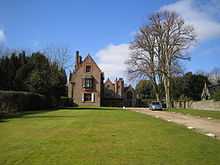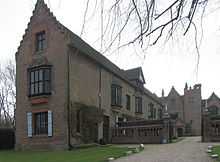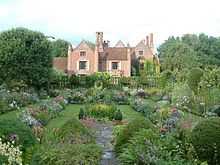Chenies Manor House

Chenies Manor House at Chenies, Buckinghamshire, southern England, is a Grade I Listed Building[1] sometimes known formerly as Chenies Palace, though it was never a royal seat nor the official seat of a bishop. It was owned by the Cheyne family, who were granted the manorial rights in 1180.[2] The current house was built around 1460 by Sir John Cheyne.[2] His widow, Lady Agnes Cheyne, left the manor house in a contested will to her niece, Anne Semark, wife of Sir David Phelip, in 1494.[3]
It is believed Chenies passed to the Semark family of Thornhaugh, Northamptonshire, to re-promote the family at court. The Sapcote family was on the side of Richard at Bosworth. Phelip married Ann Semark after Bosworth, Phelip had a close friendship with the Cecils of Burghley, the Cecils and Semark were kin.

Additions were made to the house in 1526 by John Russell, 1st Earl of Bedford[2] and in 1560 it was restyled by Francis Russell, 2nd Earl of Bedford, who had made it his principal home. Henry VIII was entertained here, as was Queen Elizabeth I in 1570.[4] The manor remained in the possession of the Russells until 1954 and is now the Macleod Matthews family home.
It is open to the public at limited times, being still used as a private house most of the time. It includes a medieval well, a dungeon and a reputed priest hole. In 2004 the British archaeological television programme Time Team undertook an archaeological dig on the site to search for evidence of former wings of the manor.[5] It is noted for its surrounding gardens, including an extensive physic garden and two mazes (one open, the other with high hedges), set in an estate village overlooking the Chess valley.

Architectural historian Nikolaus Pevsner described the manor house as: "Beautifully mellow under the trees by the church, and archaeologically a fascinating puzzle." Twenty-three individual-cut brick chimneys distinguish the house and are echoed throughout the village.
From the village green a private gravel drive leads invitingly up to the Manor House. Immediately outside the gates is the parish church of St Michael, together with the large private Bedford Chapel.
The manor has been used many times in television programmes, such as To Play the King and also Midsomer Murders. It has also been used for scenes in dramatizations of classic period novels such as by Jane Austen and more recently the TV serial Little Dorritt, based on the eponymous book by Charles Dickens, in 2008.
The gardens, famous for their tulips, are promoted by the Campaign to Protect Rural England.[6]
See also
External links
| Wikimedia Commons has media related to Chenies Manor House, Buckinghamshire. |
- Chenies Manor House website
- Semark / Phelip/Cecil/Russel Tudor lines
- Heraldry of the Bedford Chapel, Chenies
References
- ↑ Historic England. "The Manor House (Grade I) (1332531)". National Heritage List for England. Retrieved 7 January 2015.
- ↑ 2.0 2.1 2.2 "Chenies Manor House website". Retrieved 2007-12-31.
- ↑ "Extract from Chenies Church and Monuments by Adeline Marie Bedford published 1901". Retrieved 2007-12-31.
- ↑ "Chenies". Open University. Retrieved 2008-09-15.
- ↑ "The Cheyne gang". Channel 4. Retrieved 2008-09-13.
- ↑ Members Guide 2012, published by CPRE, 2012
Coordinates: 51°40′28″N 0°31′59″W / 51.674428°N 0.532966°W